
The giant muntjac, sometimes referred to as the large-antlered muntjac, is a species of muntjac deer. It is the largest muntjac species and was discovered in 1994 in Vũ Quang, Hà Tĩnh Province of Vietnam and in central Laos. During inundation of the Nakai Reservoir in Khammouane Province of Laos for the Nam Theun 2 Multi-Purpose Project, 38 giant muntjac were captured, studied, and released into the adjacent Nakai-Nam Theun National Protected Area. Subsequent radio-tracking of a sample of these animals showed the relocation was successful. The species is also located in parts of eastern Cambodia, as well as the Trường Sơn Mountains.
The Truong Son muntjac or Annamite muntjac is a species of muntjac deer. It is one of the smallest muntjac species, at about 15 kg (33 lb), half the size of the Indian muntjac. It was discovered in the Truong Son mountain range in Vietnam in 1997.

Muntjacs, also known as the barking deer or rib-faced deer, are small deer of the genus Muntiacus native to South Asia and Southeast Asia. Muntjacs are thought to have begun appearing 15–35 million years ago, with remains found in Miocene deposits in France, Germany and Poland. Most species are listed as Least Concern or Data Deficient by the IUCN, although others such as the black muntjac, Bornean yellow muntjac, and giant muntjac are Vulnerable, Near Threatened, and Critically Endangered, respectively.

The Sumatran tiger is a population of Panthera tigris sondaica on the Indonesian island of Sumatra. It is the only surviving tiger population in the Sunda Islands, where the Bali and Javan tigers are extinct.
The leaf muntjac, leaf deer or Putao muntjac is a small species of muntjac. It was documented in 1997 by biologist Alan Rabinowitz during his field study in the isolated Naungmung Township in Myanmar. Rabinowitz discovered the species by examining the small carcass of a deer that he initially believed was the juvenile of another species; however, it proved to be the carcass of an adult female. He managed to obtain specimens, from which DNA analysis revealed a new cervid species. Local hunters knew of the species and called it the leaf deer because its body could be completely wrapped by a single large leaf. It is found in Myanmar and India.

The Indian muntjac or the common muntjac, also called the southern red muntjac and barking deer, is a deer species native to South and Southeast Asia. It is listed as Least Concern on the IUCN Red List. In popular local language, it is known as Kaakad or Kakad (काकड़)

Reeves's muntjac, also known as the Chinese muntjac, is a muntjac species found widely in southeastern China and Taiwan. It has also been introduced in Europe and Japan. It takes its name from John Reeves, a naturalist employed by the British East India Company in the 19th century.
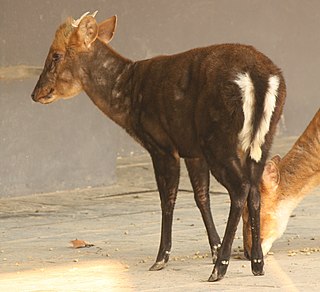
The hairy-fronted muntjac or black muntjac is a type of deer currently found in Zhejiang, Anhui, Jiangxi and Fujian in southeastern China. It is considered to be endangered, possibly down to as few as 5–10,000 individuals spread over a wide area. Reports of hairy-fronted muntjacs from Burma result from considering the hairy-fronted muntjac and Gongshan muntjac as the same species. This suggestion is controversial. It is similar in size to the common muntjac.

The Gongshan muntjac is a species of muntjac living in the Gongshan mountains in northwestern Yunnan, southeast Tibet, Northeast India and northern Myanmar.
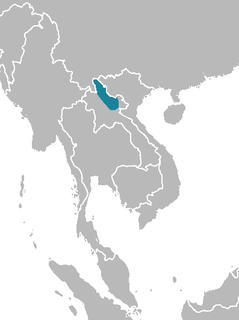
A single specimen of the Roosevelt's muntjac or Roosevelt's barking deer was presented to the Field Museum in 1929 following the Kelley-Roosevelts expedition organized by Theodore (Jnr) and Kermit Roosevelt. The specimen is slightly smaller than the common muntjac and DNA testing has shown it to be distinct from recently discovered muntjac species. It is a subspecies of Fea's muntjac, whose home range is mountains further northwest separated by lower land. However, without further evidence, the exact position of Roosevelt's muntjac cannot be stated. Berlin Zoo supposedly held this species between 1961 and 1972 but it could have been an Indian muntjac, subspecies annamensis.
The Bornean yellow muntjac is a muntjac species endemic to the moist forests of Borneo.

The Sumatran elephant is one of three recognized subspecies of the Asian elephant, and native to the Indonesian island of Sumatra. In 2011, IUCN upgraded the conservation status of the Sumatran elephant from endangered to critically endangered in its Red List as the population had declined by at least 80% during the past three generations, estimated to be about 75 years. The subspecies is preeminently threatened by habitat loss, degradation and fragmentation, and poaching; over 69% of potential elephant habitat has been lost within the last 25 years. Much of the remaining forest cover is in blocks smaller than 250 km2 (97 sq mi), which are too small to contain viable elephant populations.
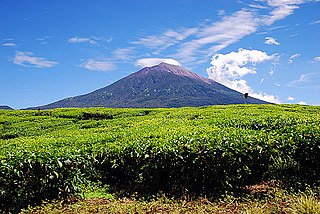
Kerinci Seblat National Park is the largest national park on the island of Sumatra, Indonesia. It has a total area of 13,791 km2, and spans four provinces: West Sumatra, Jambi, Bengkulu, and South Sumatra.
The Sumatran ground cuckoo is a large, terrestrial species of cuckoo. It was introduced to Western science in 1879 and was formerly considered conspecific with the Bornean ground cuckoo but was given status as a unique species in 2000. This elusive species was initially known from just eight specimens and evaded notice from 1916 until 1997, when it was rediscovered and photographed by Andjar Rafiastanto. The Sumatran ground cuckoo's diet is thought to consist of invertebrates, small mammals, and reptiles.
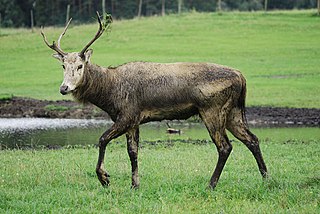
The Cervinae or the Old World deer, are a subfamily of deer. Alternatively, they are known as the plesiometacarpal deer, due to their ankle structure being different from the telemetacarpal deer of the Capreolinae.
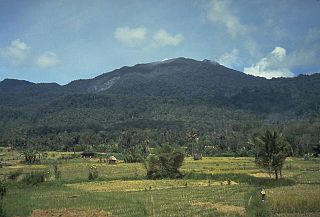
Batang Gadis is a national park covering 1,080 km2 in North Sumatra province, Indonesia extending between 300 and 2,145 metres altitude. It is named after the Batang Gadis river that flows thorough the park. Signs of the endangered Sumatran tiger and the threatened Asian golden cat, leopard cat and clouded leopard were seen in the park. The protection of Batang Gadis as a national park is part of a plan to create the Northern Sumatra biodiversity conservation corridor, which would be connected, via a series of protected areas and forests, to Gunung Leuser National Park in the north of the island.

The Sumatran clouded leopard is a subspecies of the Sunda clouded leopard and is native to the Indonesian islands of Sumatra and Batu. It differs in molecular, craniomandibular and dental characteristics from the Bornean clouded leopard. It was recognized as a valid subspecies in 2017.
The Sumatran hog badger is a species of mustelid endemic to the island of Sumatra in Indonesia.














